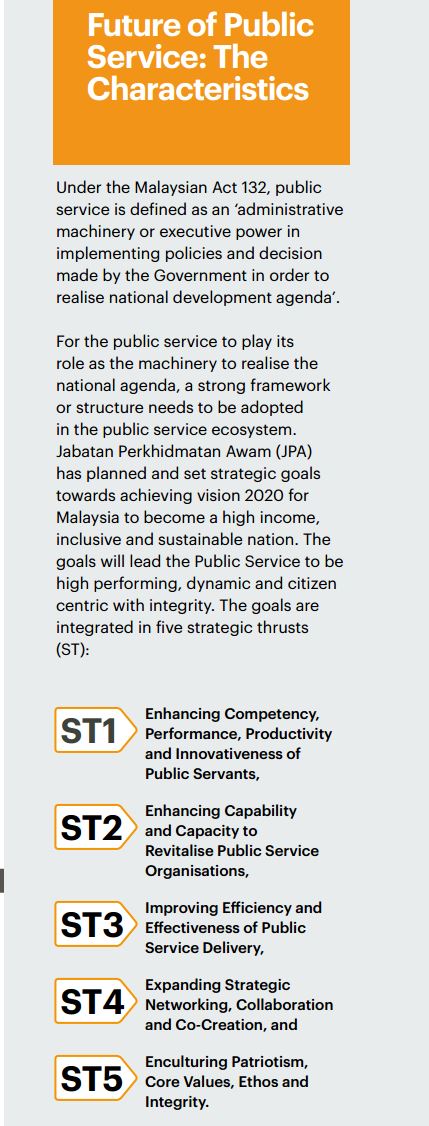by | myForesight®Analytics
The need for Public Service Transformation has been constantly mentioned by the Prime Minister, Datuk Sri Najib Razak. In the 2011 Budget speech he said,
“To attain developed nation status, we cannot remain complacent. Success demands drastic changes, not incremental. It requires a quantum leap. Change is not an option, but an imperative. We must change or risk being left behind.” This brought new challenges to the Malaysian Public Service. It has to transform and be excellent, especially in its service delivery in order to meet the demand from the public. The transformation should be able to response to the future needs, trends and challenges; and delivering services in an efficient and productive manner with high quality of leadership, trust, integrity and accountability.”
These five strategic thrusts will create a lean, agile, connected, transparent and innovative tech-savvy Public Service to embrace the upcoming challenges and the complexity of the ecosystem.
 1) Agile, Responsive
1) Agile, Responsive
- Able to anticipate situations, adapt and react optimally to unforeseen events in a speedy and cost effective manner providing needed responses in the short term without compromising long term options.
- Able to organize themselves to guide public and private resources quickly to address challenges. Able to ‘de-organize’ themselves when specific structures and processes are no longer needed.
- Agile and adaptable, including organizational structures and processes, service delivery models, civil servants and others employed in governmental work; and flexibility in regulatory and legal structures.
2) Connected and Streamlined
- Collaborate across sectors, borders and organisations, with co-ventures, co-create and co-design being key features in the service delivery toolbox. This further highlights engagement of stakeholders across a variety of platforms, both physical and virtual.
- Share services, labour and resources through networking approaches and strategies to remain slim and streamlined while delivering their mission in effective and innovative ways.
3) Flatter
- Citizen engagement – decreasing the distance between government and the people through the use of social media, mobile devices and mapping tools and other communication modes; and committing to open data that provide citizens and businesses with access to much more public information in easy to use, searchable electronic formats.
- Administrative efficiency – decreasing layers in hierarchies between top management and line personnel, removing red tape, aided by collaborative work environments, business process redesign and business analytics to foster evidence-based decision-making.
- Decision-making processes – the decision-making process can be accomplished vertically as new data and analytical processes put information where it is needed by policy-makers and others; and horizontally by building collaboration within and across government departments, agencies and ministries.
- Intergovernmental and cross-sectoral collaboration – Networks that lie across public and private sectors, non-profit organizations and various government entities to solve complex problems, gain economies of scale and scope, and leverage innovative ideas and best practices.
4)Tech-enabled, Tech-savvy and Innovative
- Both operationally as an organisation (processes, partnerships and financing, amongst others), as well as strategically.
- Policy, legal and regulatory frameworks and processes must be redesigned to align with the dynamics of the networked world. Information infrastructures must support new modes of collaboration, information and intensive governance.
- Innovative public sector organisations have the ability and capacity to incubate ideas and delivery models and accelerate their impact (scaling up via rapid prototyping).
5)Transparent
- Transparency helps rebuild trust and keeps all parties accountable for actions and outcomes.
Factors Influencing Public Service Transformation
 Public service will face unprecedented challenges that lead to complexity in the ecosystem. Therefore, the transformation plan needs to have a systematic approach in understanding the current state of public service by identifying external and internal factors that will enable future changes.
Public service will face unprecedented challenges that lead to complexity in the ecosystem. Therefore, the transformation plan needs to have a systematic approach in understanding the current state of public service by identifying external and internal factors that will enable future changes.
Internal and external factors are derived from pressing trends, issues and challenges. Whilst internal factors will directly influence the future changes in public service structure, system and behavior; the external factors indirectly influence public sector by giving significant effect to internal factors in creating new model in public service.
1) Demographic change
Demographic transition is by far the most significant challenge faced by most countries in the world. Population growth is slowing down, but the age structure of the population is changing. There would be an acute imbalance in the population structure as the numbers of young are falling whilst elderly are rising, creating significant future issues for the public sector, particularly in the areas of new generation of workforce participation, pensions and health costs.
It is estimated that by 2030 Malaysia will be in the category of ‘ageing nation’ with older persons constituting more than 15% of the population. With the rising share of the elderly in the population, apart from increased public health cost due to non-communicable diseases and disability associated with ageing, Malaysia also needs to provide funds to improve their income support schemes.
Another issue brought about by the demographic change is the rate of urbanization. According to the CIA website, the annual rate of change between 2010 and 2015 is estimated to be at 2.4%. Delivery of economic and social services need to keep abreast this change.
2) Public Perception
Public perception provides valuable input for the government in delivering its services. Apart from delivering results, the Government has been challenged to manage perception from its citizens. Public service, as the front liner of the government’s delivery system, has to ensure productive and inclusive delivery of services in order to improve public perception.
The public is very demanding. It would be difficult and almost impossible to meet all their demands. However, delivery of essential public service such as security, education and health care should always be prioritized to ensure the wellbeing of the citizen. It will indirectly improve public perception.
Public awareness increases the pressure on the government. The advancement of information technology and social media increases public awareness and has negative effect on the public perception. The public has more trust in the news circulated through the internet compared to those in the mainstream news media. One of the most damaging topics is on the integrity of the public service. Therefore, to improve public perception, the public service not only need to improve delivery but, perhaps more importantly, its integrity.
3) Inequalities
High quality public services act as a form of redistribution from the rich to the poor. Thus, public service is an important mechanism for tackling socio-economic inequalities. Issues of inequality also appear in distribution of manpower as well as budget allocations in the public service. Improving the quality of public services across the board would increase the equalizing potential of these services, and inclusive development would enable the potential to be realized.
Public service needs to provide balance between economic growths and enhancing job opportunities for the citizens to enjoy the prosperity created. Public service plan should provide sustainability between economic growth, socio-economy and society wellbeing by developing good ICT infrastructure to support public services delivery, especially in rural areas, and effective social support on targeted vulnerable group.
4) Global Competitiveness
Globalization and liberalization creates complexities in global economy, bringing new challenges to the public service. It is critical to ensure that the investment made is able to create a prosperous environment for the citizens and the nation in a globalized world. Service liberalization and talent competition causing brain drain are examples that affected public service.
The Malaysian government has taken several initiatives to improve its competitiveness. The initiatives include creating opportunity for trade liberalization to generate new jobs and skillset, and better policies for industry development. Malaysia is not only focusing on economy, but national progress in a broader measure, beyond GDP, by including social and environmental elements.
a – Infrastructure and Ecosystem Initiatives: Iskandar Malaysia and Multimedia Super Corridor (MSC) initiatives focus on tax incentives, infrastructure and ecosystem development for Malaysia to achieve its economic goals.
b – Productivity and Innovation Initiatives: Malaysia has established initiatives to enhance productivity innovation through: (a) workforce development system, (b) human capital development, and (c) minimum wage programme.
c – Malaysia Anti-corruption initiatives: The Malaysian Anti-Corruption Commission (MACC) in 2009 witnessed the establishment of a body that is independent, transparent and professional in the efforts to curb corruption. It replaced the Anti-Corruption Agency
d – Green Initiatives: 40% reduction of emissions intensity by 2020, and funds by the Ministry of Science and Technology (MOSTI) for 286 green technology projects with an amount of approximately RM213 million.
5) Safety and Security
Rapid development and urbanization create opportunity and risk such as pandemics and crimes in the city. Safety and security is of prime importance, not only for the citizen, but are also factors that would influence investors’ confidence and the region’s attractiveness as a place to live and work. New set of skills is required to combat those negative issues.
Malaysia’s effort to comply to ISO/ IEC 27001:2007 Information Security Management System (ISMS) by CNII sectors is led by the National Security Council, supported by MAMPU and Cybersecurity Malaysia. Malaysia realizes the importance of national information security system because almost everyone is exposed to various online threats and cybercrimes including white collar crime.
Advances in information technology (cloud computing, analytics, mobile computing, etc.) create vast service opportunities in the future. Technology advancements will encourage active involvement of citizens in voluntary work such as service agents. They would be able to provide vital and accurate information about the needs and problems of their communities. This would lead to better cooperation and coproduction initiatives like community policing, rakan cop, rela, rukun tetangga.
6) Technology Advancement
Government transformation program brings new operational environment to the public sector. The emphasis is towards efficient, personalized and citizen-centric services. Technology advancement acts as a catalyst to enhance accessibility and encourage connectivity, openness, participatory and transparency in delivering services. However, technology is changing rapidly. Today’s advanced communications are surely not as sophisticated as they will be in the next decade. Challenges and new issues will emerge. The questions of ethics, equal access and new strategies, therefore, require multifarious methods and solutions to address those challenges.
Government faces challenges to get the most out of the big data. Public sector’s data sources can make government more efficient, save money, identify fraud and help public service to provide better service to the citizens. Digital data storage is easier to access compared to printed documents and paper files. Malaysia in has moved to digital document management system. Currently, 70% of intra-government letters/memos, invitations, circulars and meeting minutes are available online. Malaysia targets to establish 90% of availability and usage of online services and 10% e-forms by 2020.
The current trend of Bring-Your-Own-Device (BYOD) creates a challenge as to how public service will fit between protecting government’s data and personal privacy of its employees.
7) Leadership
Leadership is a vital component of good public governance. The difficulty remains in defining the kind of leadership that is needed in relation to current and future challenges. Given the understandable level of risk aversion in the public services, building and maintaining rapport with the public at large is vital for leaders. The public service needs leaders with a different capability profile that includes public in their vision and mission.
It is essential to have a leadership with strong values. As organisational role models, the actions of leaders send a more powerful message about acceptable behaviours than any published policies or statements. Citizen demand their leaders to be consistent, up-to-date, open and flexible; apart from the ability to make good decision, intervene whenever needed, and create long term plans.
8) Financial Sustainability
Public sector financial sustainability is its financial capacity to meet the current obligations; withstand shocks; and maintain service, debt, and commitment levels at reasonable levels in relation to both national expectations and likely future income, while maintaining public confidence. To maintain financial sustainability, the government needs to emphasis on the broad and long term vision and mind set.
To achieve financial sustainability, resources need to be managed efficiently through prioritization and collaborative approaches between the organizations and the communities. Government aims to reduce the federal fiscal deficit from about four percent (4.0%) of GDP in 2013 to about three percent (3.0%) in 2015, and about zero percent (0%) by 2020. The implementation of the Goods and Services Tax (GST) in April 2015 and the gradual subsidy rationalization from September 2013 to April 2015 are two examples of government’s effort for financial sustainability.
9) Governance
Transparency and accountability are essential features of good governance. Good governance is needed to sustain development momentum and ensure that benefits of growth are widely shared. Changing governance sees more specialized, lean, flat and autonomous organization being created.
Budget transparency and good practices in procurement lead to good governance. Check and balance are paramount to ensure that transparency and accountability are well practiced. These will restore the rakyat’s confidence to the government.
10) Integrity and Value
The work of public servants must be grounded in a deep understanding of public sector values and principles. Current changes in the demand from society and the digital revolution posed a new challenge for Government in the journey towards a values- and ethics-based public service. Greater focus on new professional values and the innovation culture in the public sector allow the public to have better access to information and become more aware of their rights.
The advancement of ICT and the availability of social media lead to more information and knowledge exchanges. They enhance connectivity between the public service and the society; create openness and transparency that could lead to improved integrity of the systems and public perception of the public service.
According to OECD’s Public Sector Integrity Reviews, integrity is the corner stone of good governance. Fostering integrity and preventing corruption in the public service supports a level playing field for businesses and is essential in the effort to maintain public trust in the government.
11) Work Environment
Public service delivery has shifted towards citizen-centric and result oriented. It has become more accessible, adaptable to change and innovative. The changes are being accelerated by the advancement of technology and changes in the demographic.
Transformation of the public service ecosystem is necessary as the current demographic change poses a challenge for public service to attract and retain the right talents. MAMPU has undertaken to rebrand the public service by introducing the Public Sector Conducive Ecosystem (EKSA). The exercise aims to provide a conducive working environment, improve work culture and inculcate positive values for public servants. These, in turn will strengthen the organisational culture, improve performance and encourage innovation among public sector agencies. Public Service Transformation Framework (PSTF) was constructed based on the principle and foundation of good governance, high patriotism, values, corporate ethics and integrity, inclusive and diverse ecosystem and public service environment, and science and technology advancement. It is upheld by five strategic thrusts (ST) as follows:
- ST1 – Revitalising Public Servants,
- ST2 –Reengineering Public Organisations
- ST3 – Enhancing Service Delivery
- ST4 – Inclusiveness and ownership
- ST5 – Enculturing Shared Values
12) Communication Networking
Effective public service communication is the key to the delivery of citizen-centric services. Regular communication between public service and stakeholder improves productivity and delivery of services. The creation of more interactive multichannel communications may enable the formation of networking that may lead into partnering, co-creation, co-design, coproduction, and the formation of integrated public service.
Integrated public service increases mobility and efficiency of resources through good governance and monitoring; and reduces abuse, mismanagement and irregularities in the public sector.
For the transformation of the public service to be effected positively, several vital factors have to be taken into consideration. Perhaps the most important are integrity and good governance. And, improving integrity and governance requires the combination of several factors including good and infective leadership, skilled, knowledgeable and trained personnel, right attitude, and conducive working environment. Leaders and personnel should be equipped with knowledge and skill to keep abreast with the advancement of technology to face the ever rising public expectation, resource constrain and global competition. They must have the capability to deliver the services required of them efficiently.
Public perception is perhaps the most difficult part in the transformation process. To improve public perception, apart from effective and efficient service delivery, the public service needs to be clean and transparent. The public need to be informed and engaged through regular and effective communication.
References:
1. Accenture Outlook: Public Service: Coup d’état Radically rethinking public services
2. THE FUTURE OF PUBLIC SERVICES: Emerging findings from the Tri-borough Community Budget pilot
3. Institute for Fiscal Studies: The public sector workforce: past, present and future
4. World Economic Forum (http://www.weforum. org/)
5. World Bank (http://info.worldbank.org
6. International Budget Partnership (http:// internationalbudget.org/)
7. Public Service Delivery Malaysia & UN Public Administration Programme (http://unpan3. un.org/)
8. McKinsey Global Institute (http://www. mckinsey.com/)
9. Project NexGen PSD, Public Service Department of Malaysia 10. Future of Government – www.psrc.pwc.com
11. The Future of Government Lessons Learned from around the World – World Economic Forum
12. OECD, Public Sector Integrity Reviews (http://www.oecd.org/corruption/ethics/ publicsectorintegrityreviews.htm)
13. Public Service Department of Malaysia (http://www.jpa.gov.my/)










